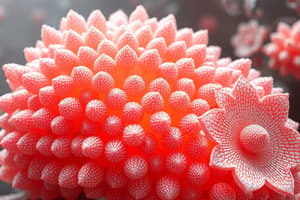Podcast
Questions and Answers
What type of gland has no ducts and secretes directly into the bloodstream?
What type of gland has no ducts and secretes directly into the bloodstream?
- Holocrine gland
- Endocrine gland (correct)
- Mixed gland
- Exocrine gland
Which type of secretion involves the destruction and detachment of the entire cell?
Which type of secretion involves the destruction and detachment of the entire cell?
- Apocrine secretion
- Exocrine secretion
- Holocrine secretion (correct)
- Merocrine secretion
What type of gland primarily secretes lipids?
What type of gland primarily secretes lipids?
- Sebaceous gland (correct)
- Salivary gland
- Pancreas
- Thyroid gland
Which type of gland secretes through exocytosis of secretory vesicles?
Which type of gland secretes through exocytosis of secretory vesicles?
Which of the following glands is an example of a mixed gland?
Which of the following glands is an example of a mixed gland?
Which of the following terms refers to the finger-like projections that increase the surface area of epithelial cells for absorption?
Which of the following terms refers to the finger-like projections that increase the surface area of epithelial cells for absorption?
What is the primary function of cilia in epithelial tissue?
What is the primary function of cilia in epithelial tissue?
Which type of junction is primarily responsible for preventing substances from passing between epithelial cells?
Which type of junction is primarily responsible for preventing substances from passing between epithelial cells?
What differentiates flagella from cilia?
What differentiates flagella from cilia?
In glandular epithelium, what are the small membrane-bound vesicles that store secretory molecules called?
In glandular epithelium, what are the small membrane-bound vesicles that store secretory molecules called?
Flashcards
Microvilli
Microvilli
Finger-like projections increasing surface area for absorption in epithelial cells.
Cilia
Cilia
Long, hair-like structures that move mucus and other substances across the epithelial surface.
Tight Junction
Tight Junction
A type of cell junction that prevents molecules from passing between cells.
Glandular Epithelium
Glandular Epithelium
Signup and view all the flashcards
Secretory Granules
Secretory Granules
Signup and view all the flashcards
Parenchyma
Parenchyma
Signup and view all the flashcards
Stroma
Stroma
Signup and view all the flashcards
Exocrine glands
Exocrine glands
Signup and view all the flashcards
Endocrine glands
Endocrine glands
Signup and view all the flashcards
Mixed glands
Mixed glands
Signup and view all the flashcards
Study Notes
Epithelial Tissue 2
- Objectives for the session include describing cell surface specializations, glandular epithelium classification, and its features.
Cell Surface Specializations
- Epithelial cells have modifications and specializations related to their functions.
- These specializations occur on all surfaces (apical, lateral, and basal).
Apical Specializations
- Microvilli: Small, finger-like projections from the cell surface into the lumen that increase the surface area for absorption.
- Cilia: Long, motile, hair-like processes that propel mucus and other structures over the epithelium through rhythmic oscillations.
- Flagella: Similar to cilia, but single and very long, found only in spermatozoa.
- Cell coat (Glycocalyx): Glycoproteins attached to the external surface of the cell membrane, composed of carbohydrate chains attached to transmembrane proteins.
Lateral Specializations
- Occluding (tight) junctions: Located between adjacent plasma membranes, prevent membrane proteins and water-soluble molecules from passing between cells.
- Adhering junctions: Located just below tight junctions, connect cell membranes and link cytoskeletons of both cells.
- Desmosomes: Weld-like junctions that resist shearing forces. Intermediate filaments disperse shearing forces.
- Gap junctions: Pores that connect adjacent cells, allowing the passage of ions, amino acids, and hormones between cells. These are present in epithelial, cardiac, and smooth muscle cells and neurons.
Glandular Epithelium
-
Glandular epithelia are specialized cells that produce secretions.
-
Secreted molecules are stored in small membrane-bound secretory granules.
-
Parenchyma includes secretory units and duct systems, while stroma is the connective tissue between the parenchyma.
-
Glandular epithelial cells can synthesize, store and secrete proteins (e.g., pancreas), lipids (e.g., adrenal glands), or complex carbohydrates and proteins (e.g., salivary glands). Mammary glands secrete all three substances.
-
Some glands have low synthesizing activity (e.g., sweat glands).
Classification of Glandular Epithelium
- Classification can be based on the presence/absence of ducts (exocrine/endocrine/mixed), mode of secretion (holocrine, merocrine, apocrine), and number of cells (unicellular/multicellular).
According to Presence of Ducts
- Exocrine glands: Secrete substances through ducts to a particular place (e.g., salivary glands).
- Endocrine glands: Secrete hormones directly into the bloodstream without ducts (e.g., thyroid gland).
- Mixed glands: Possess both exocrine and endocrine functions (e.g., pancreas).
According to Mode of Secretion
- Holocrine glands: The whole cell is destroyed and detached to release secretions (e.g., sebaceous glands).
- Merocrine glands: The cells remain intact and release secretions through exocytosis (e.g., salivary glands).
- Apocrine glands: The apical part of the cell is detached with secretions (e.g., mammary glands).
According to Number of Cells
- Unicellular glands: Single-celled structures (e.g., goblet cells in respiratory and intestinal mucosa).
- Multicellular glands: Multiple cells that secrete substances into a duct system (e.g., salivary glands).
Studying That Suits You
Use AI to generate personalized quizzes and flashcards to suit your learning preferences.
Related Documents
Description
Test your knowledge on glandular epithelium and types of secretions with this quiz. Explore various gland types, their functions, and structural features. Perfect for students studying anatomy and physiology.




